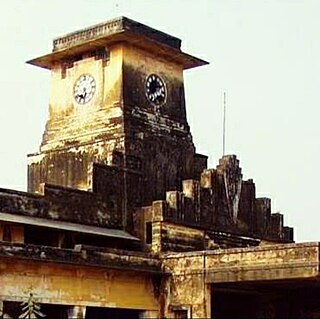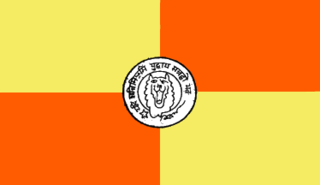Related Research Articles

The Battle of Buxar was fought between 22 and 23 October 1764, between the forces under the command of the British East India Company, led by Hector Munro, and the combined armies of Balwant Singh, Raja of Benaras; Mir Qasim, Nawab of Bengal till 1764; the Nawab of Awadh, Shuja-ud-Daula; and the Mughal Emperor, Shah Alam II. The battle was fought at Buxar, a "strong fortified town" within the territory of Bihar, located on the banks of the Gangas river about 130 kilometres (81 mi) west of Patna; it was a challenging victory for the British East India Company. The war was brought to an end by the Treaty of Allahabad in 1765. The defeated Indian rulers were forced to sign this treaty, granting the East India Company diwani rights, which allowed them to collect revenue from the territories of Bengal, Bihar, and Orissa on behalf of the Mughal emperor. This gave the company immense economic control, enabling them to pass financial policies to exploit the resources of the region for their own benefit.
Majhauli Raj is a town and a nagar panchayat in Deoria district in the Indian state of Uttar Pradesh.
The Darbhanga Raj, also known as Raj Darbhanga and the Khandwala dynasty, was a Maithil Brahmin dynasty and the rulers of territories, not all contiguous, that were part of the Mithila region, now divided between India and Nepal.
Bhumihars, also locally called Bhuinhar and Babhan, are a Hindu caste mainly found in Bihar, the Purvanchal region of Uttar Pradesh, Jharkhand, the Bundelkhand region of Madhya Pradesh, and Nepal.

The Bettiah Raj, also known as the Bettiah Empire, was the second-largest zamindari in the Bettiah region of Bihar, India. It generated annual land revenue rentals of more than 2 million rupees.
Hathuwa Raj was a chieftaincy belonging to Baghochia dynasty of Bhumihars. It encompassed 1,365 villages, was inhabited by more than 391,000 people, and produced an annual rental of almost a million rupees. It was located in the Saran Division of Bihar. Earlier seats of the Raj included Huseypur, Kalyanpur, Balchowra and Baghoch. The Kalyanpur chieftaincy was subjugated by the Mughal Emperor Akbar during late 16th century.

The Tekari Raj was a zamindari estate of the Bhumihar community in South Bihar. They controlled 2,046 villages on their estate, which covered a 7,500 square kilometres (2,900 sq mi) area, near to the town of Gaya.

Jagdishpur is a nagar panchayat town of the district Bhojpur of the state of Bihar in eastern India. It was the capital of the eponymous Jagdishpur estate, ruled by Rajputs of the Ujjainiya clan. One of its rulers, Kunwar Singh, was a major figure in the Indian Rebellion of 1857, considered the leader of the rebellion in Bihar.
Fateh Bahadur Shahi was Raja of Huseypur Raj which is situated in today's Gopalganj district of Bihar in India.

Rafa'at wa Awal-i-Martabat Maharaja Sri Chait Singh Sahib Bahadur, commonly known as Chait Singh, was a ruler of Kingdom of Benaras in northern India.
Pandey Ganpat Rai (1809-1858) was a revolutionary and rebel leader in the Indian Rebellion of 1857 and a chieftain in Lohardaga district of Bihar.
Dumraon Raj was a medieval chieftaincy and later a zamindari estate in erstwhile Shahabad district of Bihar. The total area under this zamindari was 4,85,000 acres which is equivalent to 1963 Square Kilometer.
Deo Raj, was a zamindari (estate) situated in what is now Aurangabad district of Bihar. The Deo Raj family were notable for being the protectors of Deo Sun shrine.

The Jagdishpur estate was a zamindari estate situated in modern-day Bihar, India, in erstwhile Shahabad district. The centre of the estate was the town of Jagdishpur, however the estate also included neighbouring towns and villages. The estate was also protected by a fort.

Raja Narain Singh was the Rajput zamindar of Seris and Kutumba in modern-day Aurangabad district of Bihar in India. He was active during the late 18th century and was notable for rebelling against the British East India Company.
The Mayi were a clan of Muslim Rajputs which controlled the Narhat-Samai chieftaincy in modern-day Nawada district of Bihar.

The Gidhaur Chieftaincy was a principality which controlled parts of South Bihar for much of the medieval period in India. The chieftaincy was named after the town of Gidhaur in Jamui district but its territory extended into the wider region.

Bhojpur Kadim is a historic village in Dumraon block of Buxar district, Bihar, India. As of 2011, its population was 18,243, in 3,024 households. Together with the neighboring Bhojpur Jadid, it lends its name to the surrounding Bhojpuri region.
The Barkagarh estate was a zamindari estate situated in modern-day Jharkhand, India, in erstwhile Lohardaga district. It was established by Ani Nath Shahdeo, the son of Nagvanshi king Ram Shah in 17th century. The capital of the estate was Satranji now located in south Ranchi.
Rani Shiromani was the queen of Karnagarh, during the British rule in India. She was a valiant leader of peasants who rebelled against the British East India Company. she played a major role in the Chuar rebellion in Midnapore. She created the first revolt against the British through the farmers in Midnapore. She was against the British East India Company and refused to pay taxes. Thus, she was called as the Rani Laxmi Bai of Midnapore.
References
- 1 2 3 Paramita Maharatna (2007). "Explaining Chait Singh's Revolt in Bihar (1781): The Role of the Refractory Bihar Zamindars". Proceedings of the Indian History Congress. 68: 565–572. JSTOR 44147866.
- 1 2 Anand A. Yang; Professor and Chair and Professor Golub Professor of International Studies Anand A Yang (1 January 1989). The Limited Raj: Agrarian Relations in Colonial India, Saran District, 1793-1920. University of California Press. pp. 63–68. ISBN 978-0-520-05711-1.
- 1 2 Anand A. Yang (1 February 1999). Bazaar India: Markets, Society, and the Colonial State in Bihar. University of California Press. p. 67. ISBN 978-0-520-91996-9.
- 1 2 Nagendra Prasad Verma (2005). "Repercussions in Bihar of the Rebellion of Chait Singh of Banaras". Proceedings of the Indian History Congress. 66: 845–851. JSTOR 44145897.
- ↑ Tahir Hussain Ansari (20 June 2019). Mughal Administration and the Zamindars of Bihar. Taylor & Francis. pp. 298–299. ISBN 978-1-00-065152-2.
- ↑ Gyan Prakash (30 October 2003). Bonded Histories: Genealogies of Labor Servitude in Colonial India. Cambridge University Press. pp. 88–89. ISBN 978-0-521-52658-6.
- ↑ Patrick J. N. Tuck (1998). Warfare, Expansion and Resistance. Taylor & Francis. pp. 65–66. ISBN 978-0-415-15523-6.